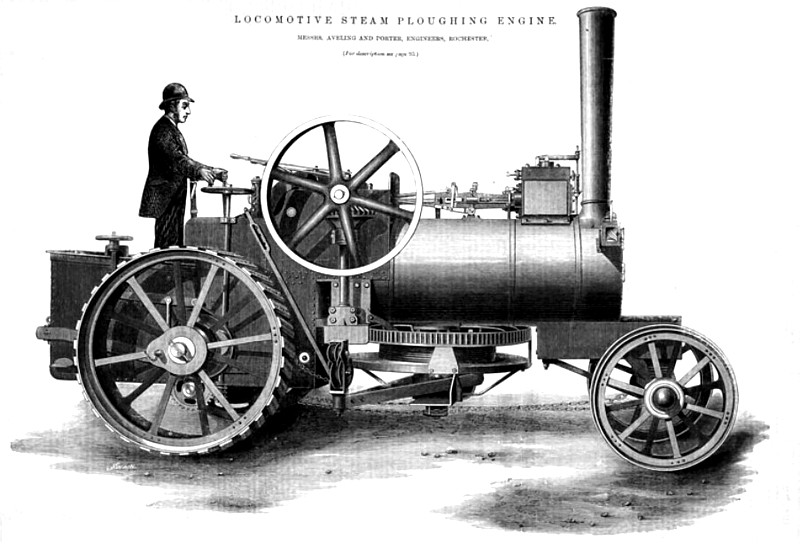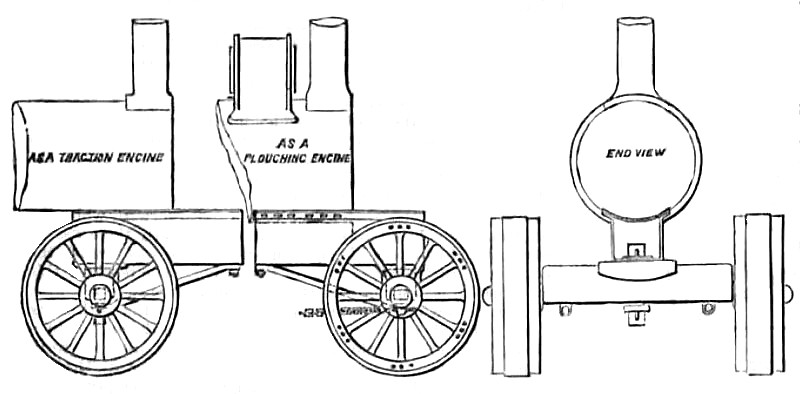|
Title: |
1875 Article-Aveling & Porter, Locomotive Steam Ploughing Engine |
|
Source: |
The Engineer Magazine, 06 Aug 1875, pgs. 94 & 96 |
|
Insert Date: |
1/10/2013 7:29:41 PM |
LOCOMOTlVE STEAM PLOUGHING ENGINE.
At page 96 we illustrate a 6-horse power locomotive steam ploughing engine—one of a pair for cultivation on the double engine system—constructed by Messrs. Aveling and Porter, and exhibited at Taunton. The engine in erected on the top of a horizontal multi-tubular boiler, and has a single cylinder 8in. diameter by 10in. stroke placed forward and surrounded a steam jacket lagged with hair, felt, wood, and sheet iron. This jacket is brought into direct communication with the boiler by means of steam ways made in the top of the shell and in the base of the steam jacket, so as to dispense altogether with outside or inside steam pipes. Although nominally of 6-horse power, the engine in capable of being worked up to more than five times the nominal power. The wrought iron driving wheels are 5 ft. diameter by 18 in. wide on the face, with wrought iron cross bars riveted on the face; the front wheels also are of wrought iron, and are 3 ft. 5 in. diameter by12 in. wide. The driving axle and intermediate shafts are of the best hammered scrap iron, and the crank shaft of Lowmoor iron turned bright; the piston rod in of cast steel; the cast iron fly-wheel is 4 ft.
diameter by 5 in. wide, with face turned bright. The crank shaft brackets are formed out of the side plates of the firebox extended upwards and backwards in one piece, and not only do they carry the crank shaft, but they provide bearings also for the intermediate shafts and driving axle in the most convenient position. The boiler in capable of generating an ample supply of steam from gas coke or coal, in butt-jointed, double riveted by hydraulic pressure, and constructed of “ best best" plates with lap-welded iron tubes 2¼ in. diameter by 6 ft. 10 in. long. It is lagged throughout with hair, felt, wood, and sheet iron, and is tested by hydraulic pressure to 200 lb. per square inch before leaving the works. The internal firebox in of Lowmoor iron. The steerage is effected from the driver's foot-plate, no that the engine can be managed entirely by one person. The engine in fitted with a powerful friction brake, which in also worked from the foot-plate. This engine is constructed with Mr. Aveling's patented improvements for enabling the pull of the rope to be taken from one engine from the land side, by which means excessive vibration and wear and tear hitherto experienced while working double sets of machinery are entirely overcome. The engine can be transformed into a road locomotive by removing the drum and putting back the front axle, an arrangement provided for in the construction of the engine. We have already described this arrangement as shown at Croydon, and we now illustrate it in the accompanying diagram. The engine in capable of hauling on good roads about 12 tons up 1 in I2, and 18 tons on a level. Its speed varies, according to the condition of the road and the weight of the load it in hauling, from one and a-half to three and a-half miles per hour. A patent winding drum in fitted to a stud bolted on to the barrel of the boiler, and is placed so that the rope can take any angle the direction of the furrow may require without putting pressure on the coiling gear. It carries 400 yards 5/8 in. but steel wire rope, and the coiling gear is arranged so as to lay the rope uniformly on the drum without attention from the man in charge. The engine is 17 ft. 10 in. in extreme length, 7 ft. 6 in. in extreme width, and 11 ft. 6 in. in extreme height. The heating surface in the fire-box: in 25 square feet, and in the tubes 131 square feet.. The workmanship of these little engines in excellent, and they have obviously been designed with great care, every precaution being adapted to prevent breaking down and to keep the cost. of repairs at a minimum for a long series of years.
Image Courtesy of Grace's Guide
http://www.gracesguide.co.uk/File:Im1875EnV40-p096.jpg |
|
 1875 Aveling & Porter, Locomotive Steam Ploughing Engine
1875 Aveling & Porter, Locomotive Steam Ploughing Engine
 1875 Aveling & Porter, Traction & Ploughing Engines Compared
1875 Aveling & Porter, Traction & Ploughing Engines Compared
|
|